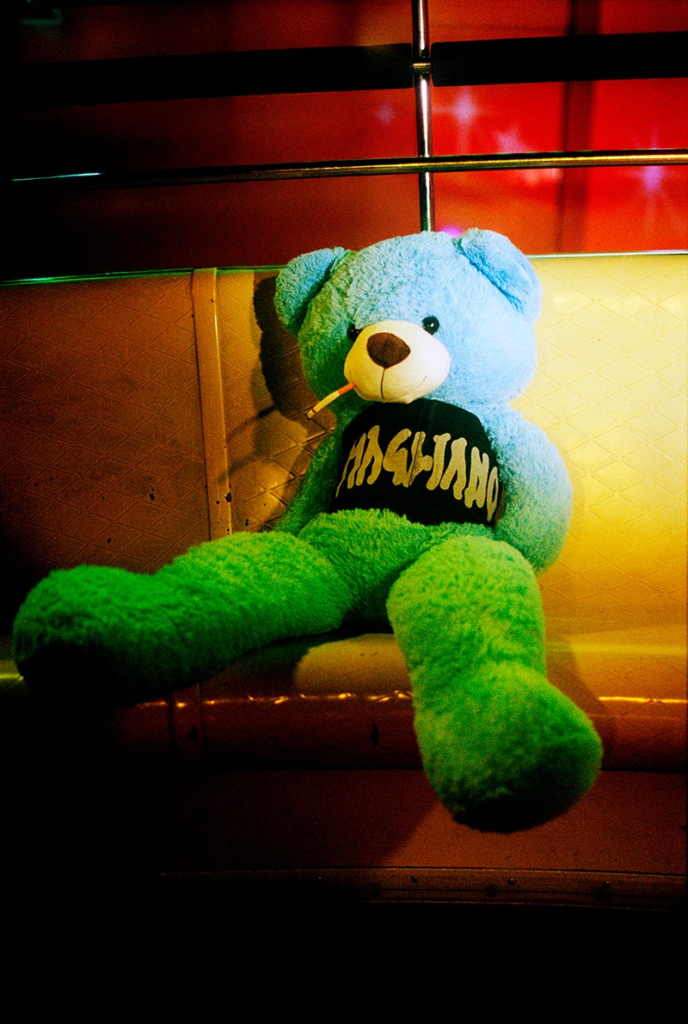The Magliano Spring/Summer 2025 campaign, titled Calcinculo, is a striking example of contemporary fashion’s engagement with historicism, subcultural aesthetics, and an evolving sartorial ethos. Shot by Joshua Gordon, the campaign operates within a carefully curated, surrealist atmosphere, utilizing the visual language of nostalgia and disorientation to present the brand’s latest collection. At its core, Calcinculo is an artistic meditation on memory, cultural identity, and the blurred lines between past and present. Through the lens of historicism, prevailing fashion trends, and the broader ethos shaping Magliano’s vision, this campaign emerges as a significant statement in modern fashion.
Historicism in Calcinculo
Historicism—the act of looking to the past to contextualize and reinterpret the present—is deeply embedded in Calcinculo. The campaign’s focal point, the Tagada ride, serves as a historical artifact of Italian teenage subcultures, particularly of the early 2000s. A staple of amusement parks and traveling fairs, the Tagada was not merely an attraction but a rite of passage for youth in Italy. Unlike conventional fairground rides, which operate on fixed tracks or mechanical precision, the Tagada’s motion is chaotic and unpredictable, controlled by the ride operator rather than the laws of physics alone. Its erratic, centrifugal force demands an active, almost performative engagement from its riders, who must attempt to balance themselves amid the spinning, jostling momentum.
Magliano’s decision to center the campaign around this culturally specific reference is a strategic act of historicism. The Tagada functions as more than a nostalgic prop; it is an emblem of a bygone era, one that today’s audience—particularly millennials and older Gen Z consumers—remembers with a mix of fondness and longing. By recontextualizing this relic within the world of high fashion, Magliano taps into the cyclical nature of style and the way subcultures of the past inform contemporary aesthetics.
Furthermore, the visual aesthetics of the campaign draw from historical references that extend beyond the early 2000s. The smoky, dreamlike atmosphere is reminiscent of the Italian neorealist film tradition, which often depicted working-class life with a raw, almost poetic sensibility. The use of haze and obscured lighting recalls the gritty, analog textures of 1990s and early 2000s photography, a deliberate contrast to the hyper-digital, high-definition aesthetics that dominate modern fashion campaigns. In this sense, Magliano’s campaign is as much an homage to a specific moment in time as it is a reinterpretation of broader historical aesthetics.
Prevailing Trends: Nostalgia, Subcultural Aesthetics, and the Anti-Polish Movement
The Calcinculo campaign is deeply aligned with prevailing trends in contemporary fashion, particularly the industry’s increasing reliance on nostalgia-driven aesthetics and subcultural references. Over the past decade, fashion has been characterized by a longing for the past, a trend that has only intensified in the post-pandemic era. Brands across the spectrum—from luxury houses like Gucci and Balenciaga to independent labels like ERL and Martine Rose—have embraced archival aesthetics, reviving silhouettes, materials, and motifs that evoke specific cultural epochs.
One of the key elements of Magliano’s campaign is its unapologetically unpolished aesthetic. This aligns with the broader anti-polish movement in fashion photography, which resists the hyper-glossy, heavily curated imagery of traditional luxury advertising. In contrast to the clean, high-resolution digital perfectionism of brands like Louis Vuitton or Dior, Magliano embraces a raw, almost lo-fi sensibility. This is particularly evident in the way Joshua Gordon captures motion—models appear blurred, as though caught mid-spin, reinforcing the visceral, dizzying effect of the Tagada.
This aesthetic choice is not merely stylistic but ideological. It reflects a growing disillusionment with overproduced luxury imagery and a return to the DIY ethos of underground fashion. Brands like Magliano, along with contemporaries such as Kiko Kostadinov, Y/Project, and Aries, are leading a shift toward authenticity and imperfection. The deliberate embrace of a chaotic, almost amateurish aesthetic challenges conventional ideas of what constitutes “luxury” and instead aligns with a grunge-inspired, countercultural approach to fashion imagery.
Another prevailing trend that Magliano taps into is the reclamation of subcultural nostalgia. The early 2000s, a defining era for European youth subcultures, have seen a massive resurgence in contemporary fashion. The Tagada, as a symbol of this era, holds a similar cultural weight to the Y2K aesthetics that have dominated fashion in recent seasons. While brands like Blumarine and Miu Miu have explored Y2K through a hyper-feminine, almost kitsch lens, Magliano takes a darker, more introspective approach, aligning itself with the gritty, unfiltered side of 2000s youth culture—one marked by dingy nightclubs, cigarette smoke, and the uninhibited chaos of adolescence.
The Ethos of Magliano: Rebellion, Melancholy, and Subversion
Beyond its historical and trend-conscious elements, Calcinculo is a manifestation of Magliano’s core ethos—one that is defined by rebellion, melancholy, and subversion. Since its inception, Magliano has positioned itself as an outsider brand, rejecting the traditional paradigms of Italian luxury fashion in favor of something rawer, queerer, and more experimental. While Italian fashion is often synonymous with sharp tailoring, opulence, and refinement, Magliano subverts these conventions by embracing distressed textures, oversized silhouettes, and a sense of beautiful imperfection.
The Tagada, as a metaphor, fits seamlessly into this ethos. Much like Magliano’s designs, the ride itself exists in a space between chaos and control, spontaneity and structure. The campaign’s models, caught mid-motion, appear vulnerable yet defiant, embodying the brand’s commitment to nonconformity and androgynous fluidity. Their clothing—draped, oversized, and layered with seemingly effortless disarray—reinforces the idea that style is not about precision but about attitude.
Another defining characteristic of Magliano’s ethos is its melancholic romanticism. While many fashion brands engage with nostalgia in a way that feels celebratory, Magliano’s approach is tinged with a sense of longing and existential weight. The heavy, smoke-filled air in Calcinculo is not just an aesthetic choice; it is an emotional one. It suggests a world caught between past and present, where memories are hazy and ephemeral. This aligns with Magliano’s broader narrative, which often explores themes of queerness, outsider identity, and a rejection of societal norms.
Conclusion: Calcinculo as a Cultural Artifact
Magliano’s Calcinculo campaign is more than a collection of striking visuals—it is a cultural artifact, a meditation on the relationship between history, fashion, and identity. By centering the Tagada as its focal point, the campaign reclaims a symbol of Italian youth culture, reframing it within the context of contemporary high fashion. In doing so, it taps into the prevailing trends of nostalgia, anti-polish aesthetics, and subcultural revival, all while staying true to Magliano’s distinct ethos of rebellion, melancholy, and subversion.
In an era where fashion is increasingly defined by its ability to remix and reinterpret the past, Calcinculo stands out as a campaign that does so with depth, emotion, and a clear cultural perspective. It is a reminder that fashion is not just about clothing—it is about memory, movement, and the fleeting, chaotic beauty of youth.
No comments yet.








